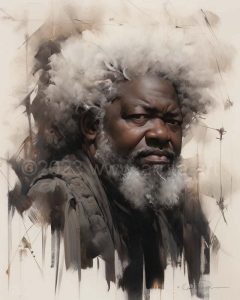Before we begin:
 The development of art has always been a reflection of the zeitgeist, encapsulating the cultural, social, and technological landmarks of its day. This has been the case since the beginning of time. Today, we are on the verge of seeing a unique union: the coming together of classical creative forms, graphic arts, and Artificial Intelligence (AI), which will result in the creation of a ground-breaking genre. In this essay, we explore this fusion, with a particular focus on how African-American mixed media studies, propelled by AI, are amalgamating with conventional visual arts. This fusion is not just a revolution in the arts but also a powerful vehicle for communicating messages of social justice and altering the attitudes of black people and artists.
The development of art has always been a reflection of the zeitgeist, encapsulating the cultural, social, and technological landmarks of its day. This has been the case since the beginning of time. Today, we are on the verge of seeing a unique union: the coming together of classical creative forms, graphic arts, and Artificial Intelligence (AI), which will result in the creation of a ground-breaking genre. In this essay, we explore this fusion, with a particular focus on how African-American mixed media studies, propelled by AI, are amalgamating with conventional visual arts. This fusion is not just a revolution in the arts but also a powerful vehicle for communicating messages of social justice and altering the attitudes of black people and artists.
The Merging of Artificial Intelligence and Conventional Art
Unprecedented potential presents itself when AI is utilized in the creative process as a partner in collaborative endeavors. It is able to evaluate enormous volumes of data, identify patterns, and suggest innovative combinations that the human mind may be unable to think of on its own. When this technological capability is combined with the richness of texture and the emotional depth of traditional visual arts, a new language of expression is created. This language breaks through the limitations of traditional creative forms, enabling a more in-depth investigation of the topics and stories that are being presented.
Studies of African Americans Working in Mixed Media: A New Perspective
The use of artificial intelligence in the study of African-American mixed media art adds a fresh facet to this form of artistic expression. AI can assist in the dissection of complicated cultural narratives, giving insights that may be missed by traditional methods of analysis. Because of this integration, artists are able to produce works that are not only visually attractive but also have profound cultural and societal importance embedded within them.
Statement from the Artist and My Own Personal Journey
As an artist who is passionately involved in investigating the different uses of creative materials, I think that incorporating AI into my palette is a natural step because it is a natural path for me to explore the varied uses of artistic materials. My artwork is a philosophical discourse that focuses on dismantling misconceptions about black artists and individuals. I use oils, acrylics, AI, pastels, charcoal, and colored pencils in my work. My path has been molded by formative experiences that have forced me to reevaluate my assumptions about established artistic conventions and cultural standards. Because of these encounters, I’ve been motivated to reevaluate the way black artists are portrayed, merging this perspective with a variety of ethnic identities.
The Role of Art as a Vehicle for Promoting Social Justice
This new kind of art, which lies at the crossroads of AI, African-American mixed media, and traditional arts, is a potent tool for social justice because it combines all three of these creative forms. It has the potential to challenge established narratives and preconceptions about black people, presenting different points of view and promoting an understanding that is more inclusive. Artists are able to create works that not only appeal aesthetically but also inspire thinking and conversation about racial and social issues by using the analytical powers of AI and the emotive power of traditional art. This allows artists to make works that not only appeal aesthetically but also appeal to a wider audience.
The final word
An important step forward in the development of artistic expression is represented by the formation of a new genre through the combination of AI, traditional arts, and graphic arts. This genre, in especially when infused with African-American mixed media studies, paves the way for artists to examine topics of identity, culture, and social justice in novel ways, opening up new channels for them to do so. As an artist who is dedicated to the investigation of this topic, I view this integration as a potent instrument for redefining perceptions and combating the preconceptions that have long cast a shadow over black artists and individuals. I see this integration as a powerful tool for redefining perceptions and confronting stereotypes. This style not only heralds the beginning of a new era in the world of art but also shines a light on the need for societal evolution and comprehension.
Discover more from Arrita Robinson, Visual Artist
Subscribe to get the latest posts sent to your email.


